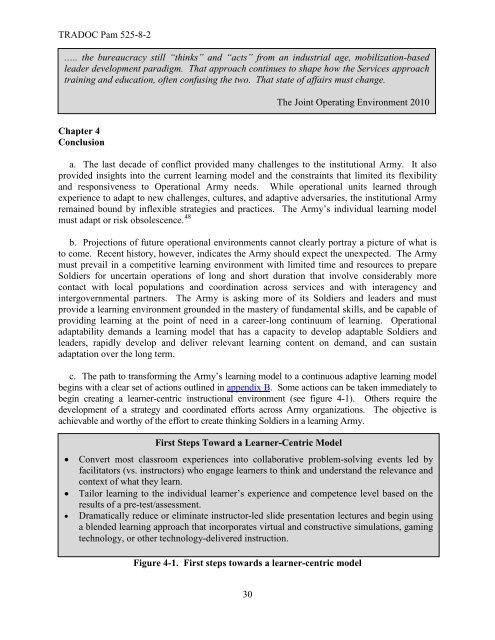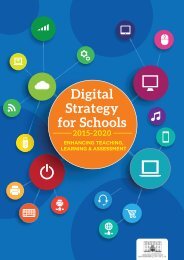K3zgZ
K3zgZ
K3zgZ
Create successful ePaper yourself
Turn your PDF publications into a flip-book with our unique Google optimized e-Paper software.
TRADOC Pam 525-8-2<br />
….. the bureaucracy still “thinks” and “acts” from an industrial age, mobilization-based<br />
leader development paradigm. That approach continues to shape how the Services approach<br />
training and education, often confusing the two. That state of affairs must change.<br />
The Joint Operating Environment 2010<br />
Chapter 4<br />
Conclusion<br />
a. The last decade of conflict provided many challenges to the institutional Army. It also<br />
provided insights into the current learning model and the constraints that limited its flexibility<br />
and responsiveness to Operational Army needs. While operational units learned through<br />
experience to adapt to new challenges, cultures, and adaptive adversaries, the institutional Army<br />
remained bound by inflexible strategies and practices. The Army’s individual learning model<br />
must adapt or risk obsolescence. 48<br />
b. Projections of future operational environments cannot clearly portray a picture of what is<br />
to come. Recent history, however, indicates the Army should expect the unexpected. The Army<br />
must prevail in a competitive learning environment with limited time and resources to prepare<br />
Soldiers for uncertain operations of long and short duration that involve considerably more<br />
contact with local populations and coordination across services and with interagency and<br />
intergovernmental partners. The Army is asking more of its Soldiers and leaders and must<br />
provide a learning environment grounded in the mastery of fundamental skills, and be capable of<br />
providing learning at the point of need in a career-long continuum of learning. Operational<br />
adaptability demands a learning model that has a capacity to develop adaptable Soldiers and<br />
leaders, rapidly develop and deliver relevant learning content on demand, and can sustain<br />
adaptation over the long term.<br />
c. The path to transforming the Army’s learning model to a continuous adaptive learning model<br />
begins with a clear set of actions outlined in appendix B. Some actions can be taken immediately to<br />
begin creating a learner-centric instructional environment (see figure 4-1). Others require the<br />
development of a strategy and coordinated efforts across Army organizations. The objective is<br />
achievable and worthy of the effort to create thinking Soldiers in a learning Army.<br />
First Steps Toward a Learner-Centric Model<br />
• Convert most classroom experiences into collaborative problem-solving events led by<br />
facilitators (vs. instructors) who engage learners to think and understand the relevance and<br />
context of what they learn.<br />
• Tailor learning to the individual learner’s experience and competence level based on the<br />
results of a pre-test/assessment.<br />
• Dramatically reduce or eliminate instructor-led slide presentation lectures and begin using<br />
a blended learning approach that incorporates virtual and constructive simulations, gaming<br />
technology, or other technology-delivered instruction.<br />
Figure 4-1. First steps towards a learner-centric model<br />
30




